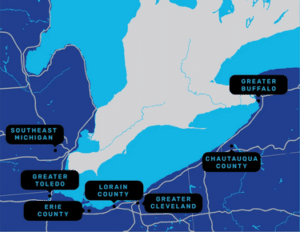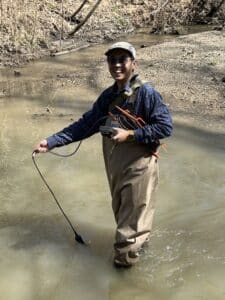
Since 2020, the Huron River Watershed Council has collaborated with other watershed and river groups across the Michigan, New York, and Ohio to advance the credibility of volunteer science and better understand the health of tributaries that flow into Lake Erie. This initiative, called the Lake Erie Volunteer Science Network (LEVSN), unites 16 geographically diverse volunteer water quality monitoring groups from Ann Arbor to Buffalo to develop a cohesive approach to volunteer water monitoring across the Lake Erie basin.
Led by the Cleveland Water Alliance (CWA), LEVSN has evolved into a regional force for community-driven water stewardship, harnessing data, technology, and collaboration to protect our shared natural resources. Regular communication among participants, including the Clinton River Watershed Council, Cleveland Metroparks, and Buffalo Niagara Waterkeeper, empowers the exchange of best practices and supports emerging local groups, fostering unity and knowledge sharing.
A rigorous framework for reliable data
In 2021, LEVSN, in collaboration with academic and government experts, introduced the Lake Erie Baseline Assessment Framework (LEBAF). This framework set rigorous standards for the collection, analysis, and communication of volunteer-collected water quality data. Armed with advanced handheld sensors and data management technology, participants ensure only reliable insights are shared with local decision-makers, collectively telling a robust regional story about Lake Erie watershed health. This year marked a significant milestone as eight participating groups undertook the inaugural LEBAF field season. Their standardized data collection efforts across 14 local waterways provided invaluable insights into the health of Lake Erie watersheds. The momentum continued into 2023, with five additional groups joining the monitoring efforts, further extending the network’s reach to Akron and Toledo waterways.
Insights into Lake Erie’s health
The data collected during the 2022 LEBAF field season offered important insights into the overall health of Lake Erie and its watersheds:
- Lake Erie and its watersheds show signs of being generally healthy and supportive of aquatic life, underlining the resilience of the ecosystem.
- Concerns surfaced about elevated conductivity levels impacting multiple Lake Erie streams, highlighting the need for ongoing monitoring to inform targeted actions that address potential impacts.
- The standardized assessment enabled LEVSN to present a regional volunteer-driven perspective on watershed conditions, serving as a benchmark for future monitoring and restoration efforts.
- To dive deeper in the LEVSN data via an interactive data dashboard, click here.

Benefits of volunteer science and monitoring
Volunteer science helps communities identify local issues, inform management decisions, and raise funds for environmental restoration. For example, data from HRWC’s Chemistry and Flow Monitoring Program informed the development of local and state policies restricting the use of phosphorus fertilizer on residential lawns. Since the adoption of these policies, phosphorus levels in the Huron River dropped an average of 28%.
Volunteer monitoring also helps build relationships and a culture of conservation. Buffalo Niagara Waterkeeper (BNW), another LEVSN partner, leverages their volunteer data into conversations with land owners that often result in long-standing relationships with community members who have the largest immediate impact on their stretch of the waterways. These individuals, in turn, become an extension of the community’s eyes on the water – keeping BNW up to date on any issues they identify on the waterways.
LEBAF is challenged by data gaps where there are no active volunteer monitoring groups and a single year’s monitoring cannot make any definitive statements on the overall health of any watershed. However, even after its first field season this standardized assessment serves as a benchmark for future monitoring and restoration efforts and has already begun to reveal crucial insights into the overall health of Lake Erie and its watersheds.
With each milestone achieved, LEVSN strengthens its capacity to drive scientific insights and community impact. As LEVSN and LEBAF monitoring continue, the data collected will enable a condition assessment of Lake Erie streams over time that can empower HRWC and other groups across the Lake Erie basin in protecting our region’s water resources and improving water quality across the Lake Erie Basin.



